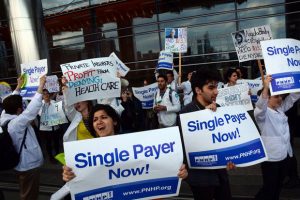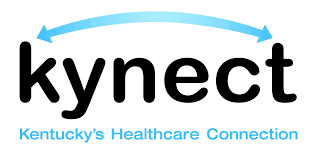 This op-ed was originally published with Scalawag Magazine on January 12, 2017. This version includes a section on how single payer healthcare can help end health disparities in Kentucky and across the country. You can read the original article here.
This op-ed was originally published with Scalawag Magazine on January 12, 2017. This version includes a section on how single payer healthcare can help end health disparities in Kentucky and across the country. You can read the original article here.
By Brandi Jones and Mallika Sabharwal, University of Louisville School of Medicine
The patient reached for his bedpan and vomited. He clutched the right side of his abdomen and groaned.
His appendix was inflamed and had to be removed. As the surgeon explained the upcoming procedure, the patient, despite being in obvious pain questioned the necessity of the impending surgery. His concerns became evident when he alluded to having a new job and “waiting for his benefits to kick in.”
While the surgeon gently reassured him of the need for the appendectomy, the patient simply responded, “Now I’m missing work, and I still don’t know how I’m gonna pay for this.”
The unfortunate reality was that although his was the first such experience I encountered on my 8-week surgery rotation, it would not be the last. More than a dozen patients relayed their concerns about the price tag associated with their necessary interventions, their regrets over not being able to get the issues addressed before they became more emergent, and the mounting costs they would face after they were discharged, when they had to get medications and schedule follow up appointments. While I listened to each person’s problems, I couldn’t help but feel that the vast majority of their distress was preventable—if only our system was better suited to truly address the healthcare needs of its people.
One of the main goals of the Affordable Care Act was to increase the number of Americans covered by health insurance, and since the ACA’s enactment, the number of uninsured nonelderly adults has fallen by 37 percent, with the largest gains among the poor, the near-poor, and minorities.
The law’s expansion of the Medicaid program was a big part of this achievement, enrolling an estimated 9 to 10 million of the previously uninsured. One of the areas most affected by the expansion was in Eastern Kentucky. Pike County, where the coal industry has abandoned jobs and the poverty rate is 23 percent, saw the greatest decrease in the uninsured rate. When the ACA took effect, the uninsured rate dropped from 13 percent to 6.6 percent – that is, approximately half of Pike County’s previously uninsured residents saw direct benefit from this implemented change.
In May 2013, Kentucky, Gov. Steve Beshear introduced a state-based online marketplace, Kynect, in compliance with the ACA and Medicaid expansion. All the plans guaranteed access to essential health benefits such as yearly checkups, emergency room and hospital visits, prescription drugs and care for pregnant women and children. Insurance plans also covered preventative care, like flu and pneumonia shots, routine vaccinations and cancer screening procedures such as mammograms and colonoscopies at no additional cost. Some plans also included dental and vision coverage and if they did not, those coverages could be purchased separately through Kynect.
Kentucky’s method of implementing the ACA was touted as a model for the rest of the country. Research from the Harvard T.H. Chan School of Public Health examined the impact of the traditional Medicaid expansion in Kentucky along with other states that did and did not opt to expand. The study found that the uninsurance rate declined by 14 percentage points in expansion states compared to states that did not expand Medicaid. The Medicaid expansion was economically beneficial, increasing jobs and tax revenues for the state. The Urban Studies Institute at the University of Louisville estimates that expanding Medicaid led to the creation of 12,000 jobs in 2014 alone and will add more than 40,000 additional jobs through 2021, which will only increase tax revenue for the state.
In 2015, however, Kentucky saw many changes following the election of Gov. Matt Bevin. True to the platform upon which he ran, the newly elected governor swiftly proposed to scrap the traditional Medicaid expansion in Kynect and to substitute a model patterned after what Indiana has implemented: a program that pushes health care costs back on Medicaid patients. The premise behind this push is that it will foster less dependency on state support and make individuals more accountable for the resources they utilize. This is not supported by data. Despite all signs pointing to this being an ill-advised, non-evidence based decision, the governor is forging ahead with his proposal to transition Kynect, the fully state-run marketplace, to Healthcare.gov, a federally supported state-based marketplace.
What exactly does this look like for Kentuckians? There will no longer be an eligibility and enrollment platform but instead an online portal for individuals to exclusively sign up for Medicaid and other federal aid programs. Enrollment into other insurance programs will be through Healthcare.gov. Insurance plans will be contracted with the federal government instead of the state. As was witnessed in Indiana, it is anticipated that the special waivers being sought would do more to increase the out-of-pocket spending (and added financial barriers for care) than it would for increasing coverage for underinsured Kentuckians. The Kaiser Family Fund reports that 72 percent of constituents said they would prefer to keep the state’s Medicaid program as it is rather than reduce coverage to fewer people. Besides reducing coverage, the plan burdens vulnerable populations, with volunteer or job requirements and locking them out if they are unable to pay a monthly premium.
Under the new waiver, individuals who have Medicaid will have to pay income-based monthly premiums and fulfill varying work requirements in order to maintain their eligibility. If they don’t meet the requirements, they could face penalties, including a temporary loss of coverage. The waiver also eliminates dental and vision coverage and sets up restrictive health savings accounts for members. The aim of this waiver system is to transition individuals towards privately-funded care. The legitimacy of this aim has been under considerable scrutiny in the literature, as it rejects the data suggesting that linking healthcare (or other social supports) to employment is not the key to mobility for most Americans.
Kentucky is a state with a long history of being ranked near the top of some lists (cancer rates, chronic lung diseases, child abuse, obesity) and the bottom of some others (education). But it was able to get a feather in its cap by launching a well-functioning marketplace through Kynect. But Governor Bevin seems to covet our worst rankings. He plans to replace the system that placed us on a national platform in a positive light with an antiquated system that has been shown time and again to be ineffective, impractical, and quite frankly, immoral. Kentucky’s Medicaid waiver proposal is de-humanizing and forces individuals to prove their worth – something uncalled-for when it comes to health care access.
If the Bluegrass State really wants to change the current system, an even better solution to Medicaid expansion is to transition to a single-payer health care system which could provide coverage for doctor, hospital, preventive, long-term care, mental health, reproductive health care, dental, vision, prescription drug and medical supply costs for every person in the state.
How would something at such a level be funded? It’s actually surprisingly simple – by dismantling private, profit-oriented insurance companies and replacing them with a single streamlined, nonprofit, public payer system. There would be no more deductibles or co-pays and no stipulations such as work-hour requirements that keep individuals uninsured. This is a system that would be privately run but government funded – similar to the way things are managed with Medicare of the VA, but improved and expanded. There is no other plan being proposed that has at its foundation a focus on the health care needs of all the people, while also being mindful of our current financial reality.
As future health care professionals who believe that access to care is a human right, we support HR 676, the Expanded and Improved Medicare for All Act. It would save billions in administrative costs, allow people to choose any doctor or hospital, and would not compromise the current health care system’s capacity with increased wait times. It would not raise costs while still allowing for innovation and the highest quality clinical care.
Although great strides have been made in Kentucky with the introduction of the recent expansion, it is still not enough. The current system, Kynect, is flawed and fails to provide enough coverage for everyone. However, rather than taking two steps backward with Governor Bevin’s proposed waiver, we argue that we must take one leap forward by making health care accessible for everyone.
Kentucky and the country need a single-payer system, a health care system that fully insures individuals and that will go beyond any Medicaid waiver in guaranteeing sustainable, equitable care for all.
 Mallika Sabharwal is a second year medical student and the president of the University of Louisville School of Medicine chapter of SNaHP. Her interests in healthcare coverage and single payer stemmed from working with Get Covered America.
Mallika Sabharwal is a second year medical student and the president of the University of Louisville School of Medicine chapter of SNaHP. Her interests in healthcare coverage and single payer stemmed from working with Get Covered America.

 This article originally appeared in In-Training. You can read the article
This article originally appeared in In-Training. You can read the article  Armide Storey is medical student at Boston University School of Medicine and co-leader of BUSM’s SNaHP chapter. She is a member of SNaHP’s media and political advocacy teams and believes that single payer is the only way to effectively address the inequity in our healthcare system. She is particularly interested in understanding health as it intersects with class, race, ability, sexuality, and gender.
Armide Storey is medical student at Boston University School of Medicine and co-leader of BUSM’s SNaHP chapter. She is a member of SNaHP’s media and political advocacy teams and believes that single payer is the only way to effectively address the inequity in our healthcare system. She is particularly interested in understanding health as it intersects with class, race, ability, sexuality, and gender.
 “My health-care experience has shown me that sometimes it’s simply not enough to pitch in and help patients on a case-by-case basis.”
“My health-care experience has shown me that sometimes it’s simply not enough to pitch in and help patients on a case-by-case basis.” Jonathan Michels is a freelance journalist, a healthcare worker and a premedical student based in Winston-Salem, NC. After graduating from UNC-Chapel Hill in 2011, Jonathan embedded with social justice activists from around the state including participants in the Occupy Wall Street, marriage equality and Moral Monday movements. When Jonathan isn’t muckraking, he works as an x-ray tech in one of the largest community hospitals in the state. Caring for Winston-Salem’s poor and uninsured informed his belief that every person has a right to healthcare. As student of various Southern organizing movements for social change, it is Jonathan’s experience that fundamental social rights like universal access to healthcare have only been won through collective struggle. Email:
Jonathan Michels is a freelance journalist, a healthcare worker and a premedical student based in Winston-Salem, NC. After graduating from UNC-Chapel Hill in 2011, Jonathan embedded with social justice activists from around the state including participants in the Occupy Wall Street, marriage equality and Moral Monday movements. When Jonathan isn’t muckraking, he works as an x-ray tech in one of the largest community hospitals in the state. Caring for Winston-Salem’s poor and uninsured informed his belief that every person has a right to healthcare. As student of various Southern organizing movements for social change, it is Jonathan’s experience that fundamental social rights like universal access to healthcare have only been won through collective struggle. Email:  “Hello Ms. Jimenez!”
“Hello Ms. Jimenez!” Bryant Shuey is a medical student at the University of New Mexico and a co-founder of UNM SNaHP. Bryant believes transitioning to a nationalized health system is essential for removing the barriers of cost and access that most Americans face when looking for health care and that it is our duty as future health professionals to advocate for our patients needs by looking to health reform for solutions. Outside of medical school, Bryant is an avid water polo player and enjoys walking his dog Susie. Email:
Bryant Shuey is a medical student at the University of New Mexico and a co-founder of UNM SNaHP. Bryant believes transitioning to a nationalized health system is essential for removing the barriers of cost and access that most Americans face when looking for health care and that it is our duty as future health professionals to advocate for our patients needs by looking to health reform for solutions. Outside of medical school, Bryant is an avid water polo player and enjoys walking his dog Susie. Email:  During a rural medical outreach visit in East Tennessee, I met a woman who had become alarmed after she found a lump in her breast. She was 44 years old, only a year younger than her mother was when she died of breast cancer at 45. The patient had not seen a physician in many years because she could not afford the copay and she had to drive 45 minutes to reach her appointment that day. She was working as a waitress and had no health insurance, which further delayed her seeking care. She had a history COPD and methamphetamine abuse, but had been clean for five years. During my exam, I felt a mass in her left breast. My alarm bells were sounding.
During a rural medical outreach visit in East Tennessee, I met a woman who had become alarmed after she found a lump in her breast. She was 44 years old, only a year younger than her mother was when she died of breast cancer at 45. The patient had not seen a physician in many years because she could not afford the copay and she had to drive 45 minutes to reach her appointment that day. She was working as a waitress and had no health insurance, which further delayed her seeking care. She had a history COPD and methamphetamine abuse, but had been clean for five years. During my exam, I felt a mass in her left breast. My alarm bells were sounding.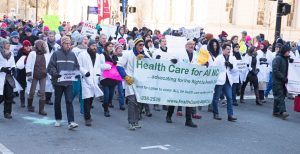
 Why:
Why: 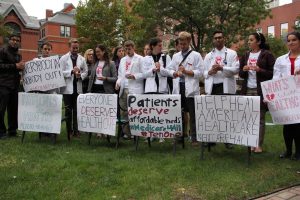 “The future generation of physicians believes in healthcare as a human right.”
“The future generation of physicians believes in healthcare as a human right.”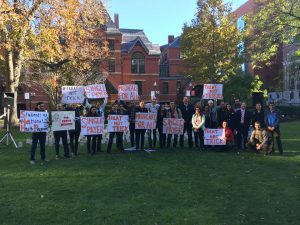 President Trump and the Republican-controlled congress propose taking away life-saving care for patients like Stephanie by repealing the Affordable Care Act (ACA) and making deep cuts to Medicaid. Repealing the ACA is estimated to result in
President Trump and the Republican-controlled congress propose taking away life-saving care for patients like Stephanie by repealing the Affordable Care Act (ACA) and making deep cuts to Medicaid. Repealing the ACA is estimated to result in  This op-ed was originally published with
This op-ed was originally published with  Brandi Jones is a third year medical student at the University of Louisville School of Medicine and past-president of the UofL chapter of SNaHP. Her interest in healthcare reform is driven by her previous experience as a mental health provider and her past research related to health disparities.
Brandi Jones is a third year medical student at the University of Louisville School of Medicine and past-president of the UofL chapter of SNaHP. Her interest in healthcare reform is driven by her previous experience as a mental health provider and her past research related to health disparities. Mallika Sabharwal is a second year medical student and the president of the University of Louisville School of Medicine chapter of SNaHP. Her interests in healthcare coverage and single payer stemmed from working with Get Covered America.
Mallika Sabharwal is a second year medical student and the president of the University of Louisville School of Medicine chapter of SNaHP. Her interests in healthcare coverage and single payer stemmed from working with Get Covered America.